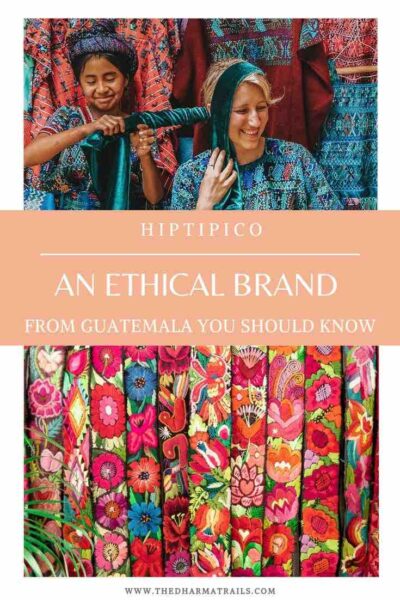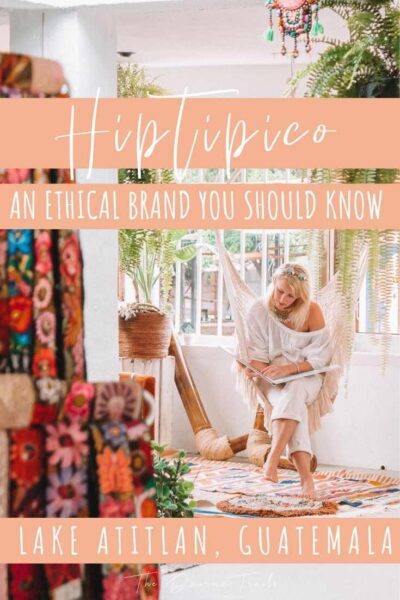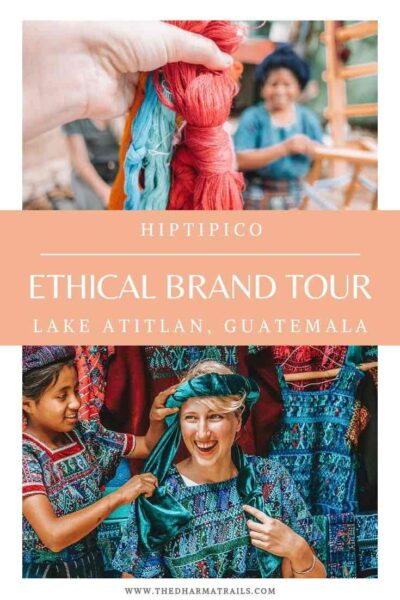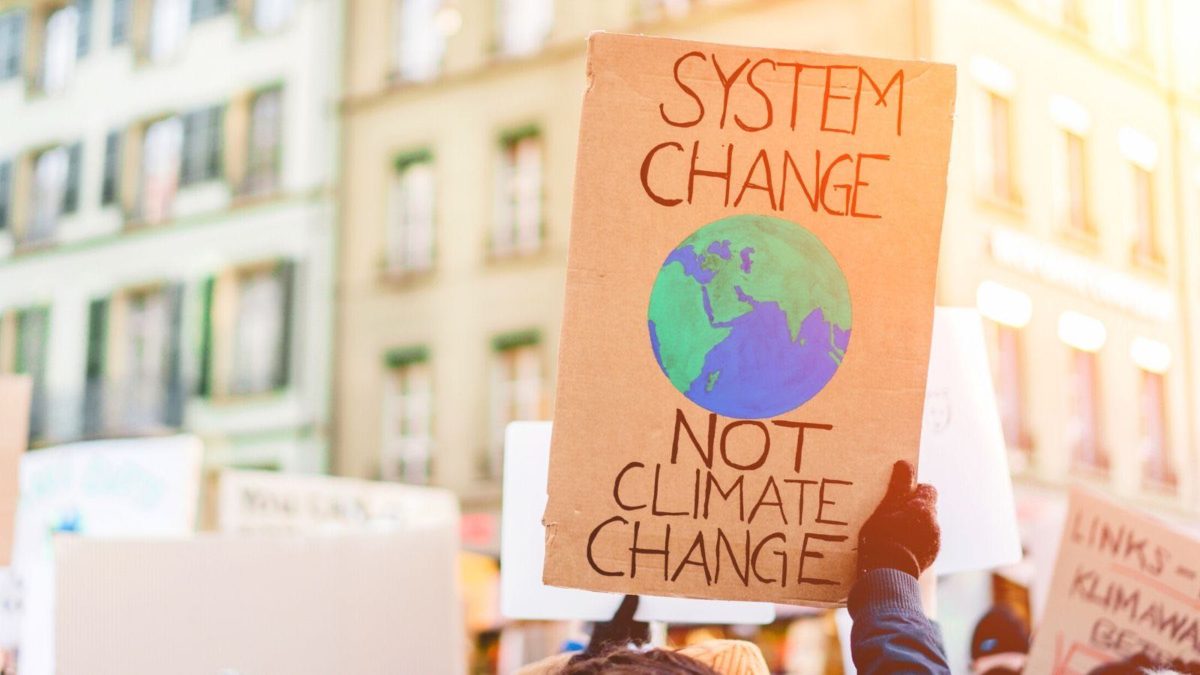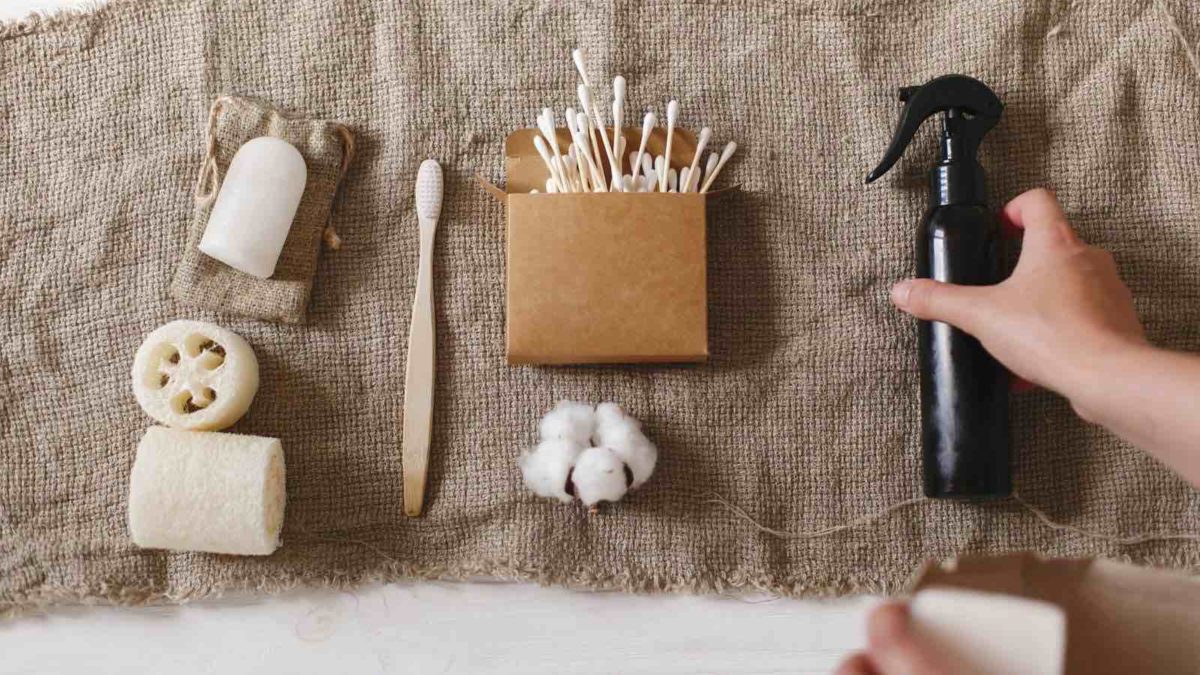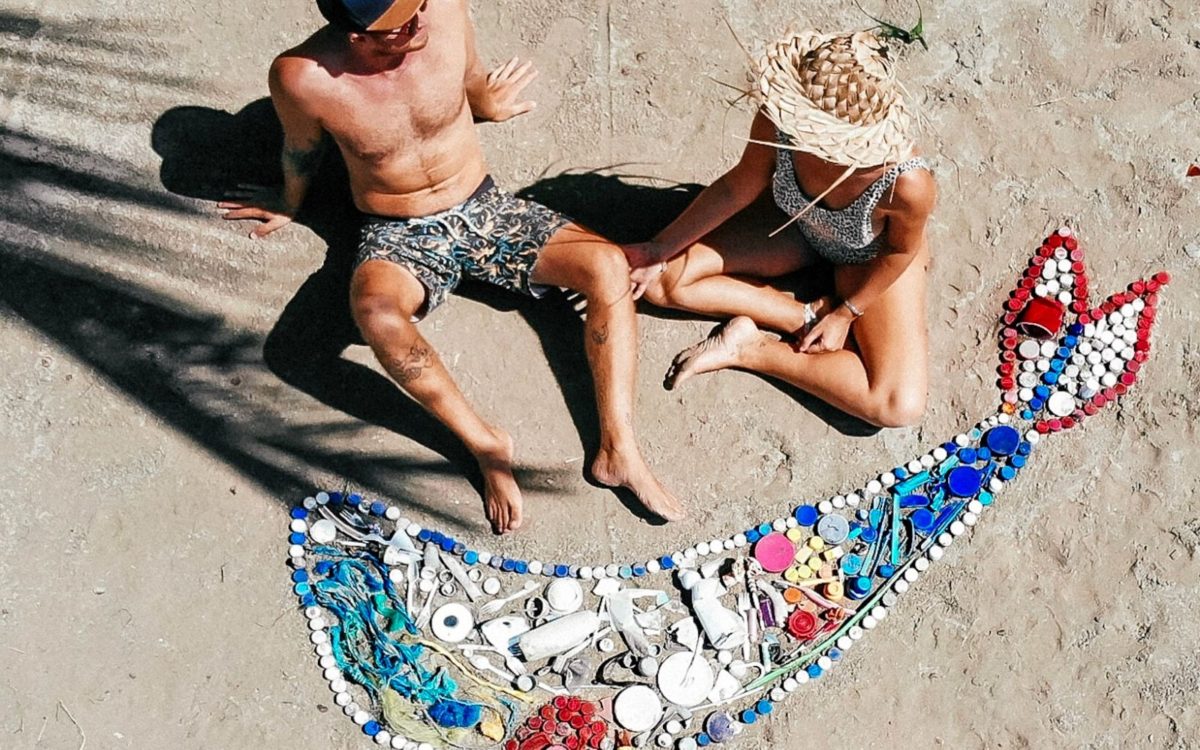The brightly coloured Hiptipico store sits between bustling lakeside restaurants and a tuk-tuk lined street. But inside the peach coloured facade is a calming world of unbelievable creativity. This ethical brand is changing the face of Guatemalan traditional art, one global purchase at a time.
This post may contain affiliate links, which means I may earn a commission if you click a link and make a purchase. As an Amazon Associate, I earn from qualifying purchases.
Using traditional handwoven fabrics, Hiptipico is doing something original, both for the artisans and the industry.
Find out what makes this unique brand one to watch (and one to visit!).
Table of Contents
What is Hiptipico?
Handmade is a term that we often take for granted. It really doesn’t give you a sense of scale or time. And with so many of our store bought items nowadays in factories, we’ve lost touch with the simple act of creation through fingers.
At Hiptipico everything is handmade.
But what really makes these items “handmade” is their uniqueness. Detailed patterns are selectively woven. There are always slight variations and imperfections. This is what makes them original.
Made Local
There is a long history of weaving in Guatemala. It dates back thousands of years to the Mayans, where colours and patterns formed part of their belief system.
While the access to finer threads and more colour choices has changed over the centuries. The hand made process (backstrap weaving) is still very much the same.
Traditionally, all girls were taught to weave and each village had its own, distinct style.
The materials used by this ethical brand are sourced locally. Each village around the lake still have their own styles & patterns.
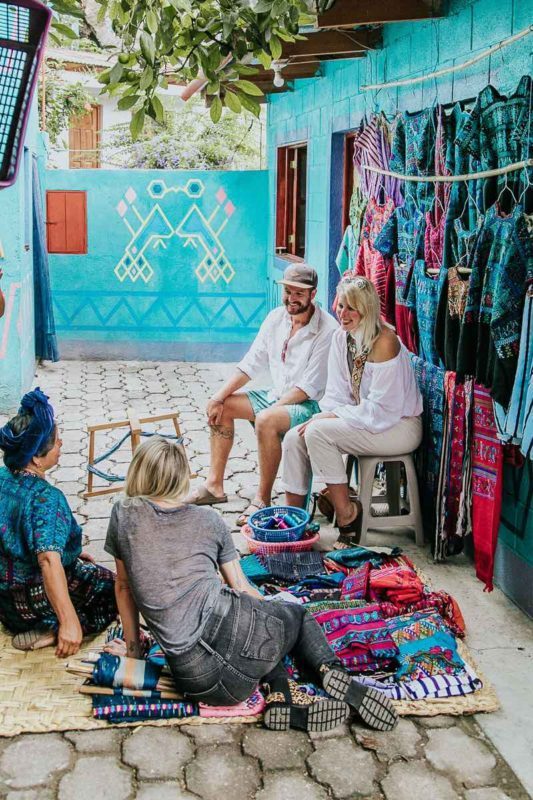
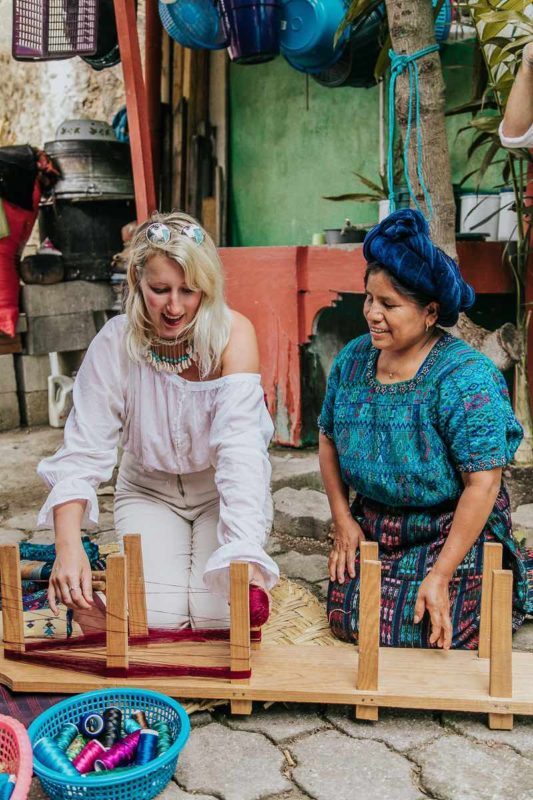
The Bridge Between Old & New
Fashion is always changing. The traditional clothing styles made by local weavers consist of rather conservative dresses and heavy tops.
There is a diminishing demand for the traditional, handwoven style of clothing.
This leaves a surplus in supply. Hiptipico has used this opportunity to adapt the traditional materials into a modern world.
Their most iconic pieces are the “straps” (you can use them for cameras, guitars, bags, etc.) These started their lives as traditional belts, but have transitioned into a unique fashion accessory for the photo inclined.
The Founder
The founder of this ethical brand, Alyssa, is from the US and has a background in economics.
While she might look and talk like someone in the fashion industry, she’s really a facilitator for the local (artisan) economy.
Her focus has always been about providing the weavers and craftsmen with opportunity rather than artistic direction.
She even states that she is “working for the local artisans”, not the other way around.
This is evident in her dedication to help families achieve financial stability through Hiptipico’s global exposure.
Where is Hiptipico?
The Hiptipico store is in Panajachel, Lake Atitlan, Guatemala.
The town is the gateway to the lake and the various villages that surround it.
“Pana” is a tourist town. But not in the traditional sense. There is still very much a local feel.
You can walk along the lake front and eat in one of the many restaurants or shop in the market stalls. Weekends are busy with a lot of Guatemalan tourists and there are always boat loads of people doing lake “party cruises”.
Locality
You can find the storefront on Calle de Lago (connected to the Playa Linda Hotel).
By Appointment
The store is a display/working space rather than a traditional shopfront. It is best to communicate with Hiptipico instagram account if you want to come in (there is normally someone online during business hours).
How to get to Hiptipico
Once in Pana, you can walk to the store (the town in not very big). Alternatively, you can take a tuk-tuk anywhere within the town area for 10Q (about $USD 1.5).
- From La Aurora International Airport to Pana – 3.5 Hours by shuttle
- From Antigua to Pana– 3 hours (Take the Tourist Shuttle for USD$40 per person)
- Santa Cruz to Pana– 5 minute boat ride on public speed boat for 10 Quetzal per person
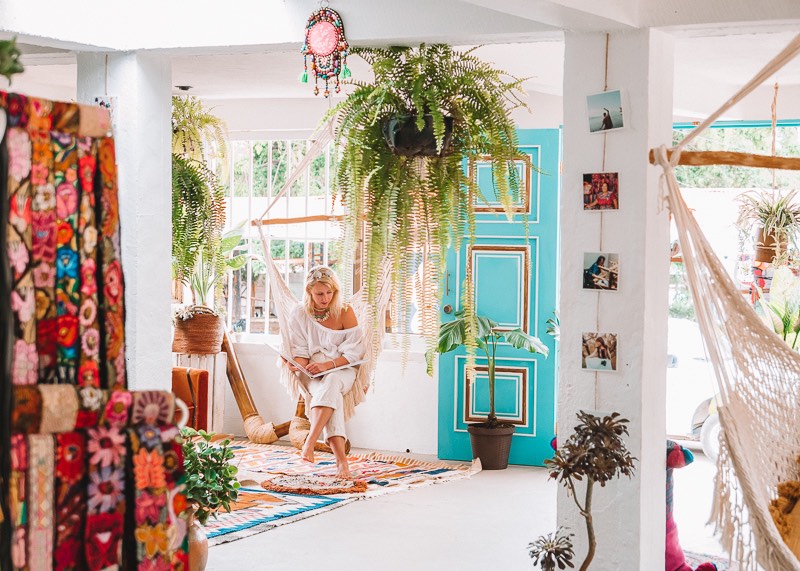
What makes it an Ethical Brand?
The concept of ethics in a business is a complicated topic. Even the term sustainable fashion is a complex web of ethical choices. But when ethical fashion brands (ethical clothing brands) talk about “ethics”, they are referring to how their product is made. Using terms like ethically made, ethical clothing or fair trade fashion.
“Fair trade certified” labels refer to workers pay and conditions along the supply change.
In this ethical brand’s case, it’s really quite simple. It starts with transparency and positive, social impact.
Fair Trade
Fair Wages & Working Conditions
- Workers set their own selling rates & working times
- Support to budget raw materials is given
- In many cases artisans work from home (they can care for their children in between weaving)
- Those that work in cooperatives share the workload and profits
Community Support
- Providing employment and a broad sales opportunity for the local market/industry
- Financial aid to working artisans:
- Emergency funding for medical bills
- School fees
- Personal loans
Environmentally Conscious Points
- Hiptipico products are often made using up-cycled material (sustainable materials)
- The handmade element keeps the production slow. Therefore no large storage warehouse full of bulk items
- Locally produced means that there is no prior shipping to get storefront
- There is a line of natural dye products
- Many items use leather. It is sourced as a bi-product of the local meat farm. However, as an alternative, vegan leather is available by request
What does Hiptipico Make?
While this ethical brand can deal with some specialty items on request, they do specialise in three main items.
Hiptipico Straps
The most iconic of all products. The Hiptipico Camera Strap. A woven or embroidered strap with leather finishings that can be used for cameras, bags, guitars, or anything else you want.
Most straps began their lives as belts, either worn as part of the traditional dress (or with intention too).
Each strap is unique a the colour variation is outstanding.
Hiptipico Bags
Bags are made out of pieces of woven or embroidered fabric stitched together with leather. There are a variety of sizes and styles (of which can be customised depending on your style).
They are a practical statement piece with a beautiful backstory.
Hiptipico Pouches
Material offcuts are predominately used to make the pouches/clutch bags (nothing gets wasted!). These provide the perfect storage item for your camera or other electrical goods inside
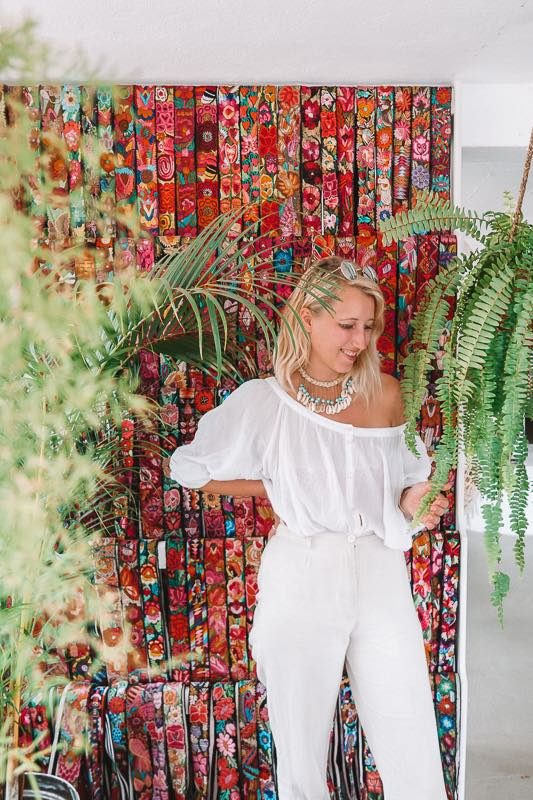
How the products are made?
Traditional methods are used to create all of the Hiptipico products.
Looms
Looms have been around for thousands of years and the technology has changed very little.
Their fabric production uses two loom types:
- A backstop loom
- A floor pedal loom
In addition to the weaving/loom process. Additional, hand woven elements are added throughout the process to create intricate designs.
Urdidora
This simple frame setup is underrated in the weaving procedure. (We got to try it ourselves in the tour, and it’s not easy).
It’s basically an unravelling/organising device.
The cotton thread comes in balls (artisans purchase them at various distributors). The balls of thread have to be organised. This is before the threads can fit through the weaves. This organising process can take days (juts to make one top).
Needlepoint Hand-Embroidery
Many embroidered items nowadays are made in factories by machines. But not here. Each (embroidered) strap is done with a needle and thread!
Hand Worked Leather
All leather works (cutting, stitching & stamping) is done by hand by the local artisan.
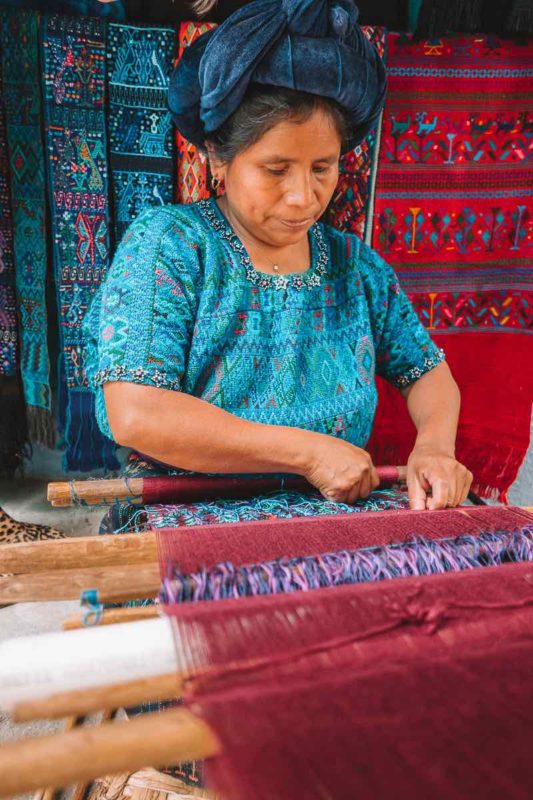
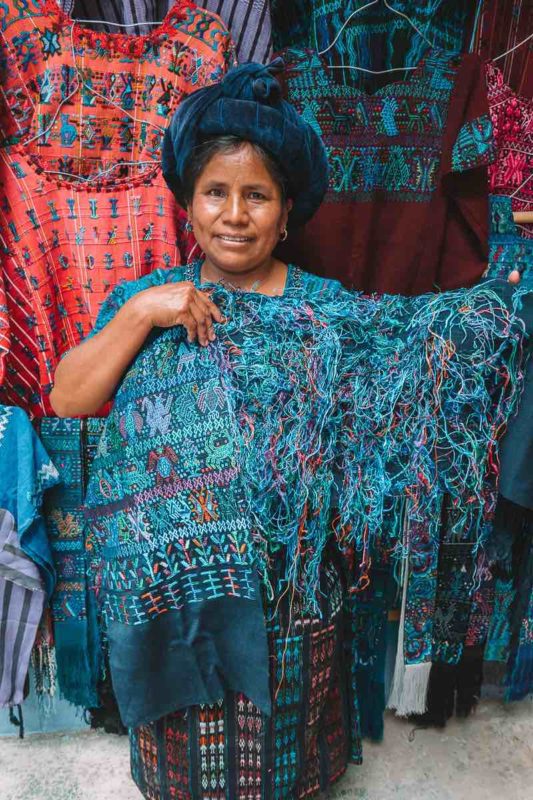
Where can you buy it?
Hiptipico ships worldwide through their online store. They frequently have new items coming in and older items on sale. Their online sales can be shipped out in a couple of days. And if you want to make custom pieces (depending on the pieces) could take a few days or up to a week. With so many beautiful pieces to choose from, it can be a great eco-friendly gift for a friend! We’ve also found some great sustainable wrapping ideas for you to try.
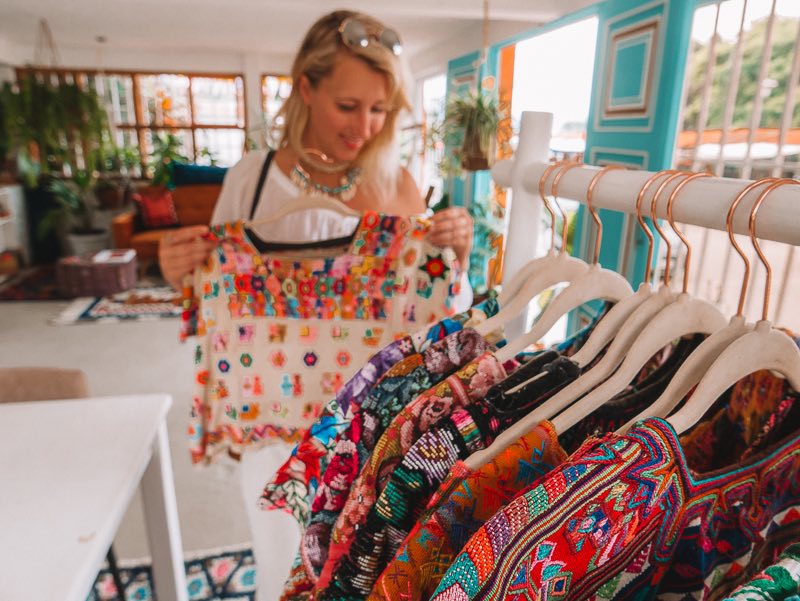
The Hiptipico Tour
If you make it to Lake Atitlan in Guatemala, the Hiptipico day tour is a must. They offer a few different tours (depending on the day of the week, which artisans are available, etc).
But all cover a similar format, that highlights the various steps of Hiptipico’s process.
The different tours & locations include:
- Panajachel
- Textile market tour
- Artesian shopping experience
- San Antonio Palopo
- Village tour
- Weaving workshop
- Ceramic workshop
- Santa Catarina Palopo
- Town tour
- Family home of artisan weaver
- Volcanic hotspring
- San Juan La Laguna
- Village tour
- Natural dye lesson
- Weaving lesson
- Market & art gallery tour
- Chichicastenango
- Tour for ethical sourcing at Central Americas biggest market
The Santa Catarina Tour
The town of Santa Catarina is quickly turning into a living piece of art.
For the last couple of years colourful walls have been popping up around every corner. It’s a purposeful movement to create interest in the town and encourage tourism.
The idea is to create positive social impact. And it seems to be working.
There are some incredible designs and colours, with more homes and storefronts getting onboard.
But besides the colourful buildings, there is a positive mood in the town. Kids are playing everywhere and they all want to say hello. It is a really great environment to explore.
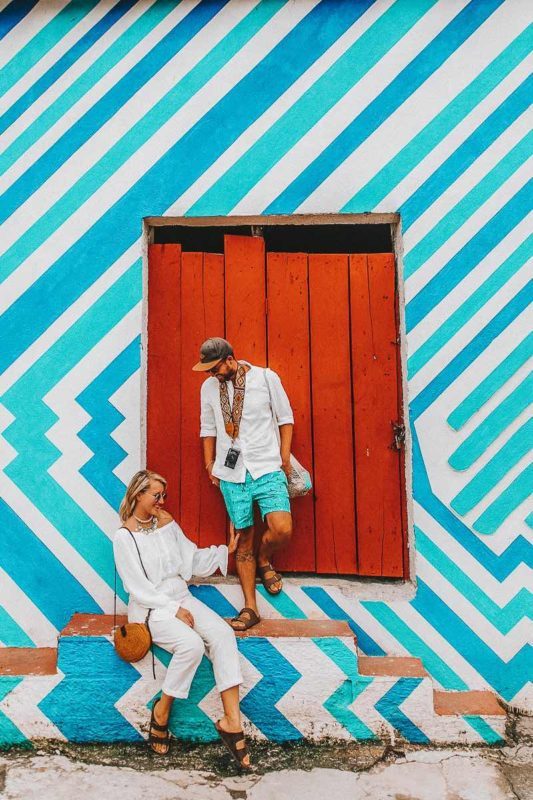
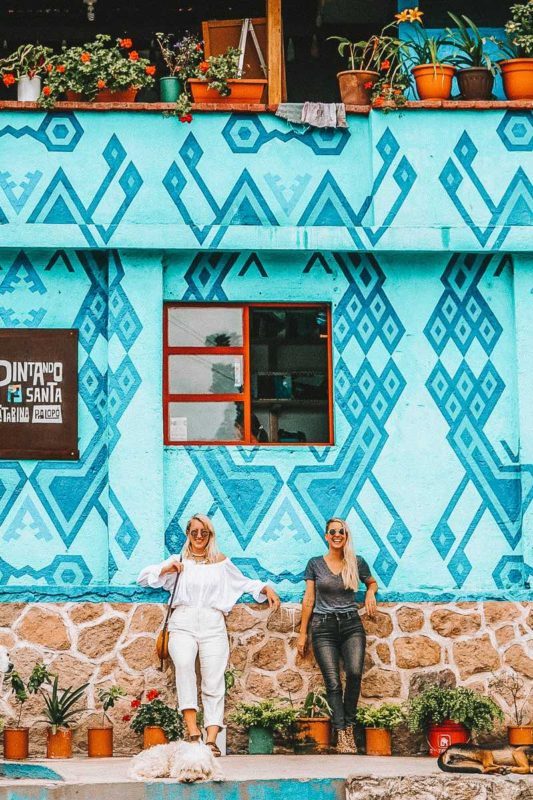
Teresa’s Home Visit
Teresa is one of this ethical brands longest working artisans (over 6 years). This part of the tour goes directly to her family home, from where she works.
It’s definitely not the kind of place that you would find on your own. You walk through a series of twists and turns right up into the hills of the Santa Catarina village.
Teresa and her daughters are waiting for you with their unforgettable smiles and beautifully handwoven attire.
You then go through the weaving process. Learning just how long each part really takes! The patience needed to achieve these pieces is truly remarkable. You will understand after you have tried for yourself.
Teresa is happy to show and talk about all aspects of her work (with one of Hiptipico’s staff to translate! Luckily for us the founder Alyssa was there).
In additional to the fabrics and clothes Teresa also makes small greeting cards out of fabric pieces which are perfect for a gift (or to hang up on a wall).
We have a new found level of appreciation for the fabrics sold through Hiptipico. Each piece is truly a handmade piece of art (that takes a lot longer than you would think to make).
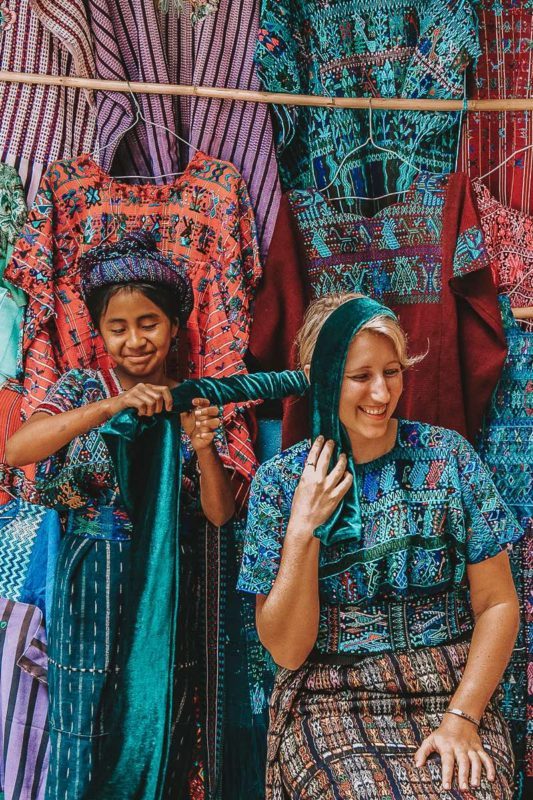
The Lake View
There is a stunning lake viewing pier in town where you can see across to the double volcanoes.
Looking back at the town and seeing the blue coloured buildings is definitely a sight we will remember.
Things to do in Panajachel
Go to the food market
There is a great little food market (best days are Tuesdays and Sundays) called the Mercado.
It’s easily reachable by foot from the Hiptipico store (or you can take a tuk tuk).
With piles of fresh fruit and handmade tortillas, it’s a worthwhile stop in the bustling lake town.
Paddleboard on the Lake
You can swim in Lake Atitlan, though parts around Panajachel are quite polluted. Luckily there are clean-up attempts (even using Artificial Intelligence).
The best places to swim are away from the towns. The Santa Cruz side of the lake (10 minutes by public ferry) is pretty clean.
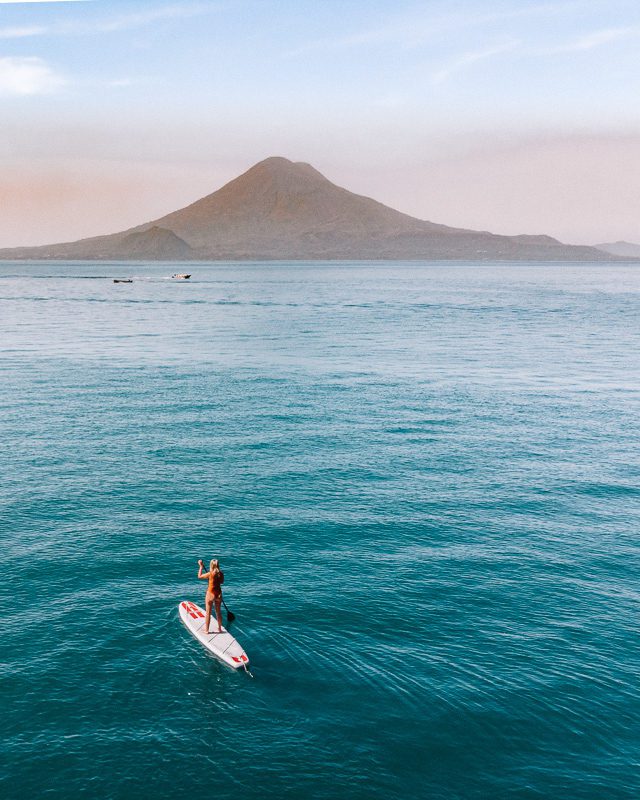
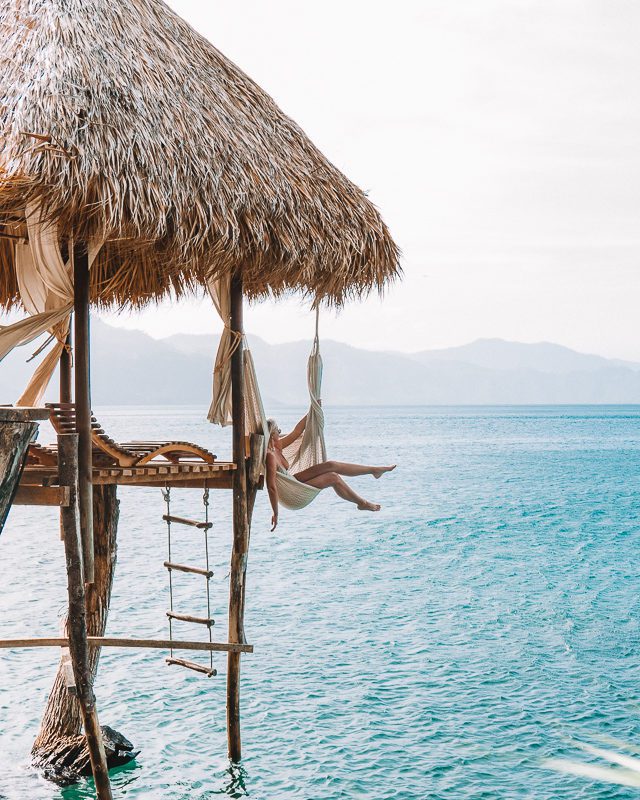
Places to Stay Nearby
There are some amazing eco accommodations around the lake. Be sure to check them out as a green stay experience.
Laguna Lodge
A true eco tourism establishment. Laguna Lodge has won various global awards. With a unique blend of traditional and modern architecture and decor, a private 100 acre nature reserve and a full vegetarian menu, it’s one to visit at Lake Atitlan. All their waste is recycled as they strive for a carbon neutral footprint.
La Fortuna
La Fortuna is a beautiful eco luxury hotel (with only 5 bungalows). Completely off the grid, they have amazing rooms (built using eco friendly materials), a wood fired hot tub, standup paddleboards and some super friendly dogs on site.
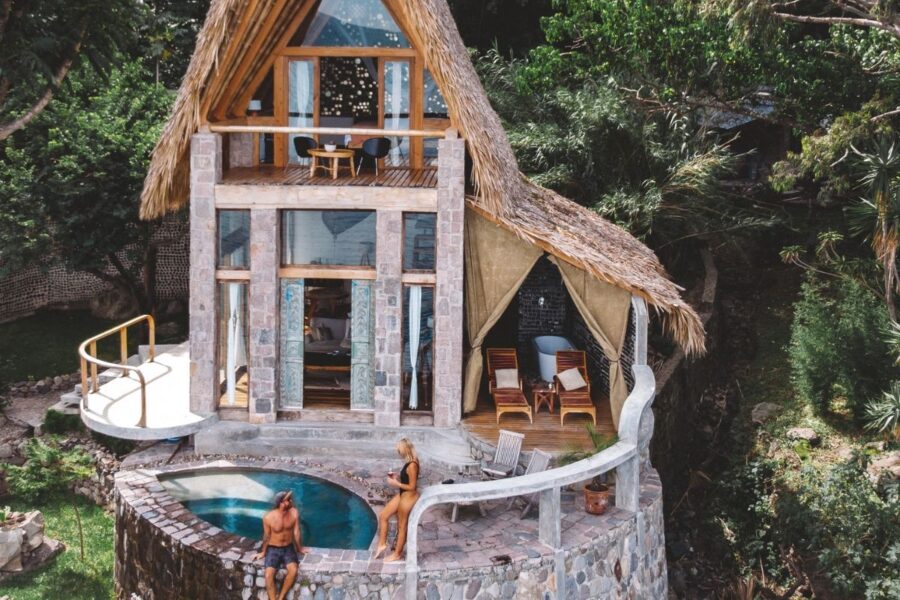
Airbnb
There are some amazing Airbnb’s around the lake. If you don’t mind walking down 280 steps to get to the water “The Lakehouse Atitlan”, halfway between Panajachel and Santa Catarina is a great spot.
Click here to get $39 towards your first trip.
Hostels
- The Dulces Sueños – has mountain views, dorms and private rooms
- San Jorge La Laguna – is a homestay experience with a local family
Support Sustainable & Ethical Brands
Whether you are wanting to travel to Guatemala or not, you can still support this industry.
As consumers, we have the decision and power to choose wisely. By continually making better choices, we are dictating the market and more companies will follow, creating greater transparency and products better for us, the workers, and the environment.
Click here to see more sustainable eco travel ideas or products.
Like This Article? Pin it!
